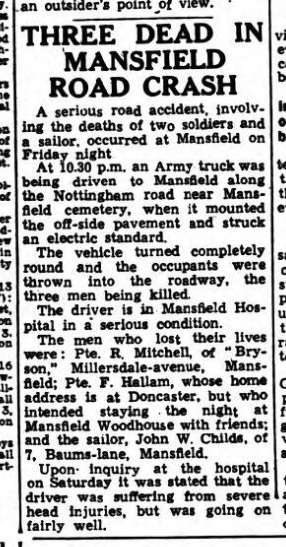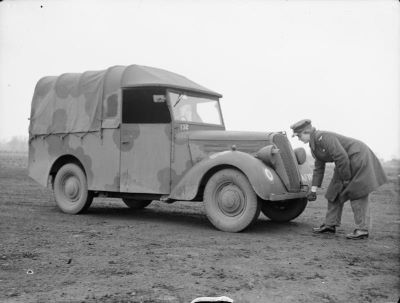(Continued from previous post – Bigamy Blues)
Tragic Story
The revelation that her new husband was actually a bigamist must have been very upsetting for Reuben Lamb’s new bride, Mary.
Mary E. Mitchell had already become a young widow just three years before meeting Reuben; discovering her second marriage was invalid would have come as quite a blow.
Through a combination of the 1939 register and marriage records, I found that Mary E. Mitchell was born Mary Evans White. In June of 1942, when she was 19, Mary married Richard Mitchell, a young soldier who served in the Sherwood Foresters. The marriage was cut tragically short when, only a few months later, Richard was killed in a vehicle accident.
The story becomes even more heart-breaking after finding out the accident happened while Richard was returning home on leave – presumably eager to see his new bride.

THREE DEAD IN MANSFIELD ROAD CRASH
A serious road accident, involving the deaths of two soldiers and a sailor, occurred at Mansfield on Friday night.
At 10.30 p.m. an Army truck was being driven to Mansfield along the Nottingham road near Mansfield cemetery, when it mounted the off-side pavement and struck an electric standard.
The vehicle turned completely round and the occupants were thrown into the roadway, the three men being killed.
The driver is in Mansfield Hospital in a serious condition.
The men who lost their lives were: Pte. R. Mitchell, of “Bryson,” Millersdale-avenue, Mansfield; Pte. F. Hallam, whose home address is at Doncaster, but who intended staying the night at Mansfield Woodhouse with friends; and the sailor, John W. Childs, of 7, Baums-lane, Mansfield.
Upon inquiry at the hospital on Saturday it was stated that the driver was suffering from severe head injuries, but was going on fairly well.(Nottingham Journal, 24 August 1942, p4, c6)

Van Tragedy Sequel
Case Against Driver Fails at Mansfield
THE triple tragedy on Nottingham-road, Mansfield, near the cemetery gates, at 10.30 p.m. on 21 August, when two soldiers and a sailor going on leave were fatally injured in a motor accident, had a sequel at Mansfield police-court yesterday, when the driver of the Army utility van concerned, John Unsworth (19), whose home address is 1, Allen-row, Paddock, Huddersfield, was charged with dangerous driving. After a long hearing, the magistrates dismissed the case, stating, however, that it was a proper charge to be brought for investigation.
Unsworth, who was returning from Nottingham, where he had been on duty, was at the time giving a lift to the three men who were killed in the crash. the dead were: John William Childs, Navy signalman of Baum’s-lane, Mansfield; Pte. R. Mitchell, Sherwood Foresters, of Millersdale-avenue, Mansfield, and Pte. F. Hallam, R.A.S.C., whose home was at Doncaster.
“Broken Lamp-post”
Supt. W. Boler (prosecuting) said that at a bend in the road the van had apparently travelled 80 yards on the offside grass verge, broken off a lamp-post, and swerved back to its correct side, where it collided with a tree. Practically the whole of the nearside of the car was torn away.
An Army sergeant named Maitland would say, said the superintendent, that an Army van passing him about a mile before the scene of the crash was travelling at at least 55 m.p.h. and he saw no other traffic.
In a statement to the police Unsworth said that in passing the road barrier at the top of the hill he reduced speed to 30m.p.h. from about 35-40 m.p.m [sic]. “About 50-100 yards past the barrier,” he continued, “I hit an obstacle which might have been a large brick. The steering wheel flew out of my hands, and I think I swerved to the right-hand side of the road. I wrenched the wheel over to the left, and then to the right, to make myself square on the road. I felt a crash. Something thing [sic] hit me on the head. It might have been a lamp-post or a tree. I don’t remember anything else.”
Still in Hospital
Supt. Boler said that after the accident the steering-gear was found to be in perfect condition, and he found nothing which would cause a vehicle to “bump.”
Mr. W. Gamble (defending) contended that there was no direct evidence as to how Unsworth was driving other than his own statement. From the moment he hit some obstacle he knew little about what happened. He sustained severe injuries and was still in hospital
Nottingham Journal 05 November 1942, p4, c4

TRAGIC STORY OF A LIFT
Verdict on Three Dead Soldiers at MansfieldA SOLDIER, Pte. R. Mitchell, and sailor, John W. Childs, belonging to Mansfield, and a second soldier, Pte. F. Hallam, of Doncaster, were killed on the Nottingham road, Mansfield, on the night of 21 August, when an Army utility vehicle in which they were being given a lift from Nottingham collided heavily with a tree.
The driver of the vehicle, John Unsworth, of Paddock, Huddersfield was also injured, and he appeared at the Mansfield Borough Court on 4 November on a charge of driving the vehicle in a manner dangerous to the public.
The Bench, after a hearing lasting over three hours, dismissed the case, finding that the accident might have been due to an error of judgment.
Yesterday the District Coroner (Lt.-Col. Bradwell) held an inquest at Mansfield on the three victims of the accident, and the chief witness was the driver. He was still wearing the hospital blue.
Statement By Driver
The long statement he made at the police hearing (which appeared in the ‘Journal’) was read over to him, and in reply to the Coroner he added that in approaching Mansfield he slowed down to 30 m.p.h., when suddenly the vehicle got out of control. In trying to steady it with the foot brake, he might have accidentally put his foot on the accelerator. That was the opinion on thinking further over the matter
The Coroner returned a verdict of “Accidental death,” and expressed his sympathy with the relatives.
An officer, who accompanied the driver of the vehicle to the inquest, also offered sympathy on behalf of the Army authorities.
(Nottingham Journal, 02 December 1942, p4 c5)
Three years later, Mary was to meet Reuben and the aforementioned drama would unfold. But their story wouldn’t end there!
(To be concluded in Bigamy Blues – Part 3)

